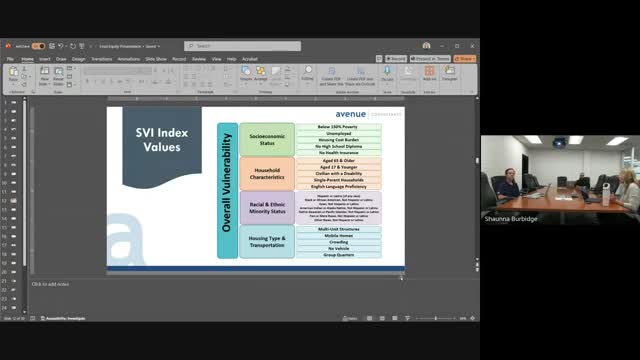Housing Crisis Exposes Struggles of Vulnerable Families
October 13, 2024 | Utah Department of Transportation, Utah Transportation, State Agencies, Organizations, Utah Executive Branch, Utah
This article was created by AI summarizing key points discussed. AI makes mistakes, so for full details and context, please refer to the video of the full meeting. Please report any errors so we can fix them. Report an error »

During a recent government meeting, officials discussed critical socioeconomic factors affecting housing stability in the community. The conversation highlighted various demographics facing significant challenges, including low-income individuals living below the poverty line, the unemployed, and those burdened by high housing costs. Many of these individuals allocate a substantial portion of their income to housing expenses, often leaving them with limited resources for other necessities.
The meeting also addressed household characteristics that contribute to vulnerability, such as the elderly, young children, and families with disabilities. Single-parent households and those with limited English proficiency were identified as particularly at risk. The discussion emphasized the importance of recognizing racial and ethnic minority status, noting that non-Caucasian households are disproportionately represented in these categories.
Housing types and transportation issues were also examined, revealing a prevalence of multi-unit structures, such as apartments and townhouses, as well as mobile homes. The officials pointed out concerning trends of overcrowding, where multiple families or generations share a single housing unit. This situation often arises when economic hardships force families to combine resources, leading to scenarios where several individuals, sometimes up to 18, reside in one household.
Additionally, the meeting highlighted the challenges faced by those living in group quarters or without access to personal vehicles, particularly in areas near universities where non-related individuals often share living spaces. The officials underscored the need for targeted interventions to address these complex housing issues and support vulnerable populations within the community.
The meeting also addressed household characteristics that contribute to vulnerability, such as the elderly, young children, and families with disabilities. Single-parent households and those with limited English proficiency were identified as particularly at risk. The discussion emphasized the importance of recognizing racial and ethnic minority status, noting that non-Caucasian households are disproportionately represented in these categories.
Housing types and transportation issues were also examined, revealing a prevalence of multi-unit structures, such as apartments and townhouses, as well as mobile homes. The officials pointed out concerning trends of overcrowding, where multiple families or generations share a single housing unit. This situation often arises when economic hardships force families to combine resources, leading to scenarios where several individuals, sometimes up to 18, reside in one household.
Additionally, the meeting highlighted the challenges faced by those living in group quarters or without access to personal vehicles, particularly in areas near universities where non-related individuals often share living spaces. The officials underscored the need for targeted interventions to address these complex housing issues and support vulnerable populations within the community.
View full meeting
This article is based on a recent meeting—watch the full video and explore the complete transcript for deeper insights into the discussion.
View full meeting

